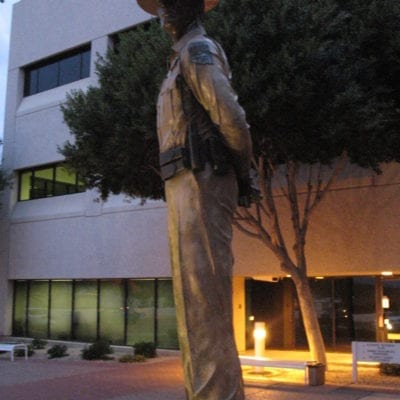Author: Mike Callahan
On August 3, 2014, at 3:41 p.m. the wife of Lewis Conlogue placed a 911 call to report that her husband was threatening suicide in LaGrange, Maine. She reported their location and stated that her husband had left their vehicle and put a gun to his head. Penobscot Deputies and Maine State Police quickly responded, moved the wife out of danger, set up a command post, secured the perimeter and strategically positioned officers.
Trooper Thomas Fiske and two other troopers took a position across the street from Conlogue about 200 feet away. Sergeant Hamilton, a member of the State Police tactical team, arrived and took up a position within the perimeter. Although Sgt. Hamilton could not see Trooper Fiske and the other two troopers, he was in constant radio contact with them during the entire incident. Trooper Fiske had a direct line of sight to Conlogue and reported that he had a semi-automatic pistol, was sitting on a rock and had the pistol pointed at his head. He remained like this for some time but then stood up and started pacing slowly around. Sgt. Hamilton repositioned himself about 413 feet from Conlogue and was able to see him through the magnifying scope on his rifle.
Trooper Fiske reported that Conlogue appeared to be assessing the situation by looking 360 degrees around the area. Sergeant Sheehan of the Penobscot Sheriff’s Office used a loudspeaker to repeatedly order Conlogue to put down the pistol. He told Conlogue that the officers were worried about him and wanted to help him. Conlogue responded with obscenities, then went to his vehicle, retrieved a knife and put it in his back pocket. Conlogue next placed his fingers in the form of a firearm and pointed directly toward Trooper Fiske and the other two troopers with him.
Conlogue began to move slowly in the direction of the three troopers. He stopped briefly and moved a little closer (it is not clear how close). He held up a fully loaded magazine and inserted it into the pistol. He pointed the pistol at a 45-degree angle over the heads of the three troopers. This action caused a spate of additional commands to drop the pistol. Conlogue ignored the warnings and alternated between pointing the gun to his head and toward the troopers with a slight angle over their heads. Trooper Fiske reported on his radio that he was not comfortable with Conlogue’s threatening conduct. Sgt. Hamilton determined that Conlogue presented a deadly threat to his fellow troopers and fired one round at Conlogue with his rifle. The bullet struck Conlogue and he was killed.
Conlogue’s wife sued Sgt. Hamilton for excessive force pursuant to 42 U.S.C. § 1983. The Federal District Court Judge dismissed the suit and determined that Sgt. Hamilton was entitled to qualified immunity. The Judge concluded that Sgt. Hamilton reasonably surmised that “Conlogue posed an immediate threat to the troopers when he pointed his gun over their heads, and that no other remedial action was feasible given the tense, rapidly evolving situation and the various failed attempts at de-escalation.”
The opinion of the First Circuit
The First Circuit Federal Court of Appeals affirmed the decision of the lower court for the following reasons:
The court ruled that Hamilton was entitled to qualified immunity because “an objectively reasonable officer…would have thought it appropriate to deploy deadly force against an armed man who, after a nearly three-and-one-half-hour standoff in which he was repeatedly warned to drop his weapon, persisted in pointing a loaded semi-automatic firearm narrowly above the heads of three officers and within easy firing range.” The court observed that Sgt. Hamilton was aware that Conlogue had been warned numerous times to drop his weapon and that he was slowly moving toward the troopers and pointing his firearm in their direction. Sgt. Hamilton was also aware of Trooper Fiske’s expressed concern (i.e., fear for personal safety) based upon Conlogue’s threatening actions. The court rejected the plaintiff’s claim that the officers were not immediately threatened by Conlogue because he only pointed the gun over their heads and not directly at them. The court explained, “Conlogue’s gun was pointed in the direction of the troopers – and the fact that he was aiming it over their heads is cold comfort. Practically speaking, there is very little difference in the threat level between a gun aimed directly at a person’s head and a gun aimed at a 45-degree angle over the person’s head.” The court likewise rejected the claim that the warnings given to Conlogue to drop his gun were insufficient because he was not told that he would be shot if he failed to drop the weapon. The court stated that in deadly force situations, officers must warn a suspect before using lethal force when possible. The court explained that in this case, “Conlogue received several clear and timely warnings to drop his weapon. As long as the warning is clear and timely…police officers need not use any particular set of magic words.” Implications of the case
This case is important for several reasons:
- It demonstrates how quickly a call to prevent a suicide can become a deadly threat to responding officers. It shows how a federal appellate court can faithfully apply the rule of law set forth by the United States Supreme Court (see the Supreme Court decisions in Tennessee v Garner and Graham v. Connor), and by doing so, rule in favor of law enforcement officers who are trying to do nothing more than save lives while protecting their own. The facts reveal a situation in which one officer took decisive action to prevent deadly harm to his fellow officers.
Sgt. Hamilton’s actions here are commendable and worthy of special mention.






